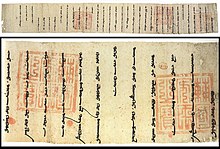Rabban Bar Sauma
Rabban Bar Sauma (Bar Ṣaumā, Syr .: ܒܪ ܨܘܡܐ, * approx. 1220 in Beijing , † January 1294 in Baghdad ) was a Nestorian monk and diplomat.
Bar aumā was born into a wealthy Nestorian family in Beijing. According to Gregorius Bar-Hebraeus he was of Uighur descent, according to Chinese sources he belonged to the Onguden Turkic people. Some Turkic peoples had joined the Mongols and were part of the ruling class of the Mongol Yuan dynasty in China. At the age of 23 he became a monk and gained a reputation as an anchor and teacher.
In 1275/76 he went on a pilgrimage to Jerusalem with his pupil Rabban Markos (1245-1317) with the approval of Kublai Khan . Due to fighting in Syria , they had to cancel their trip in Armenia . They went to the Catholicos Patriarch Mār Denḥā in Baghdad, who appointed Markos Metropolitan of China. After the patriarch's death in 1281, his pupil Markos was elected as his successor. He took the official name Yahḇallāhā III. at (1281-1317). Bar Ṣaumā became archdeacon and the patriarch sent him to the court of the Ilkhan Abaqa . When the Ilkhan Arghun wanted to send an embassy to Europe to offer the rulers of the West an alliance against the Mamluks , the patriarch recommended his old teacher to him.
In 1287 he first traveled to Byzantium to see Emperor Andronikos II. Palaiologos . The Holy See was vacant in Rome , so he traveled on to Western Europe. In Paris he negotiated in September 1287 with King the beautiful Philipp and in Bordeaux , he met with the English King Edward I together. On Palm Sunday 1288 he received communion from the newly elected Pope Nicholas IV. The Vatican was delighted with his reports on the wide spread of Christianity in Asia and that several women of the Mongol rulers were Christians. However, his efforts to form an alliance with Christian rulers were unsuccessful. The conquest of Acco by the Mamluks in 1291 ended the age of the Crusades .
After his return he settled in the Ilkhane residence in Maragha and built a church.
Bar Ṣaumā's journey is not as well known as Marco Polo's simultaneous journeys in the opposite direction. His detailed Syrian travelogue, perhaps written in Persian by the Catholicos Timothy II based on Bar Saumā's notes , is the only non-European source on Europe in the final stages of the Crusades .
literature
- James A. Montgomery: History of Yaballaha III. Columbia University Press, New York 1927
- EA Wallis Budge: The Monks of Kublai Khan. Religious Tract Society, London 1928 ( online )
- Alexander Toepel (ed.): The monks of Kublai Khan. The journey of the pilgrims Mar Yahballaha and Rabban Sauma to Europe. Scientific Book Society, Darmstadt 2008
Web links
- Encycl. Britannica
- BookRags about Bar Sauma
- Church encyclopedia about Jahballaha III. ( Memento from June 29, 2007 in the Internet Archive )
- Cape. 26 in René Grousset: Histoire de la Chine ( MS Word ; 979 kB)
| personal data | |
|---|---|
| SURNAME | Rabban Bar Sauma |
| BRIEF DESCRIPTION | Nestorian monk and diplomat |
| DATE OF BIRTH | around 1220 |
| PLACE OF BIRTH | Beijing |
| DATE OF DEATH | January 1294 |
| Place of death | Baghdad |
